Business Strategy Game (BSG) Simulation Strategic Decision Report
VerifiedAdded on 2023/01/17
|11
|3776
|97
Report
AI Summary
This report provides an in-depth analysis of strategic decisions made during a Business Strategy Game (BSG) simulation, focusing on the performance of C Company. The analysis encompasses the evaluation of major strategic decisions, including those related to earnings per share, return on equity, and stock price, highlighting the impact of these decisions on the company's financial performance. The report further examines the application of six key strategic models: PEST analysis, SWOT analysis, and others, illustrating how these models informed C Company's decision-making process and contributed to its competitive advantage. The report delves into the use of various strategies such as best cost and blue ocean strategies and details competitive factors such as wholesale pricing, S/Q rating, and advertising expenditure. The report also discusses the significance of CSR and the balance needed between CSR spending and business growth. The simulation results are presented to demonstrate the strategic approach and its effectiveness in enhancing the company's market position and financial metrics. This report provides a comprehensive overview of the simulation and its impact on C Company's strategic direction.
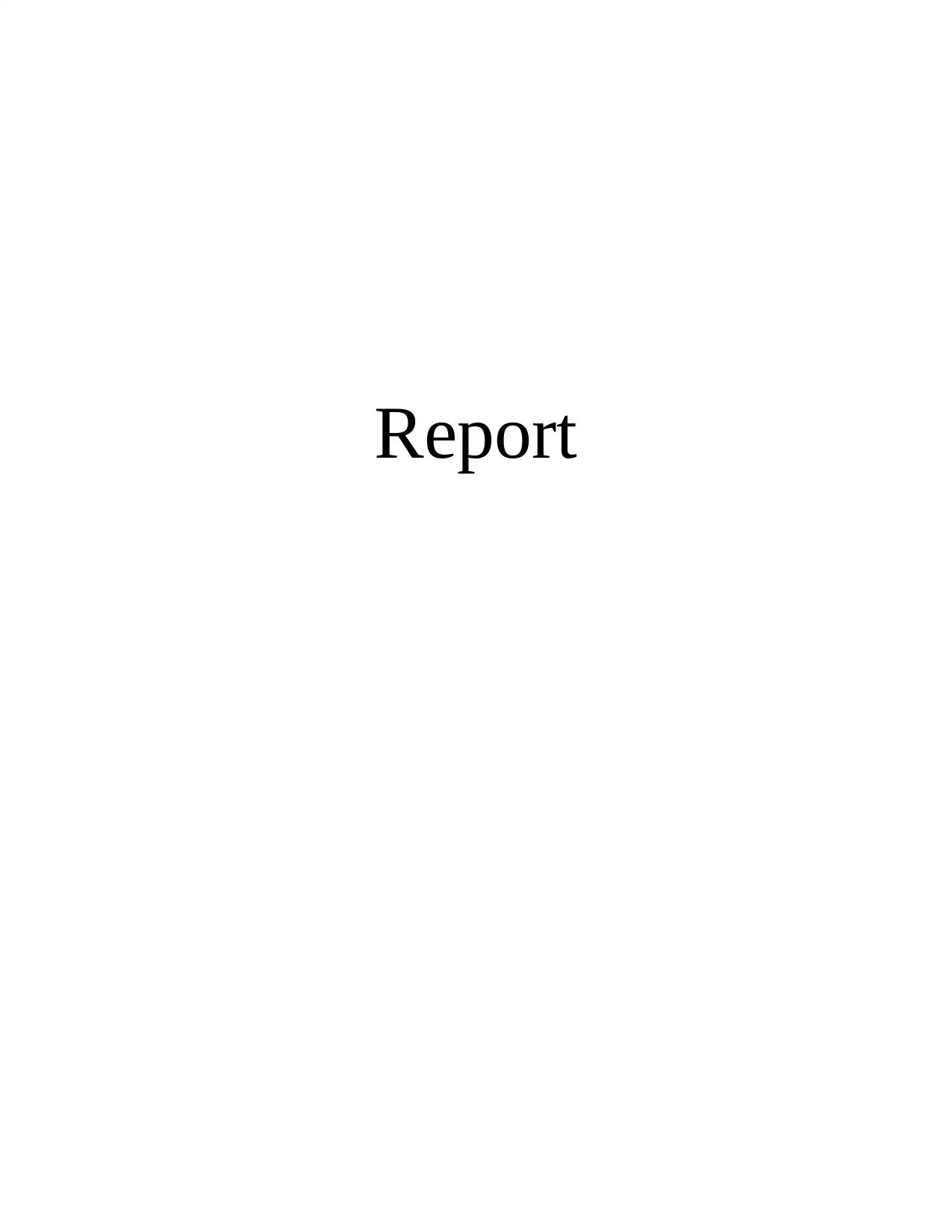
Report
Paraphrase This Document
Need a fresh take? Get an instant paraphrase of this document with our AI Paraphraser
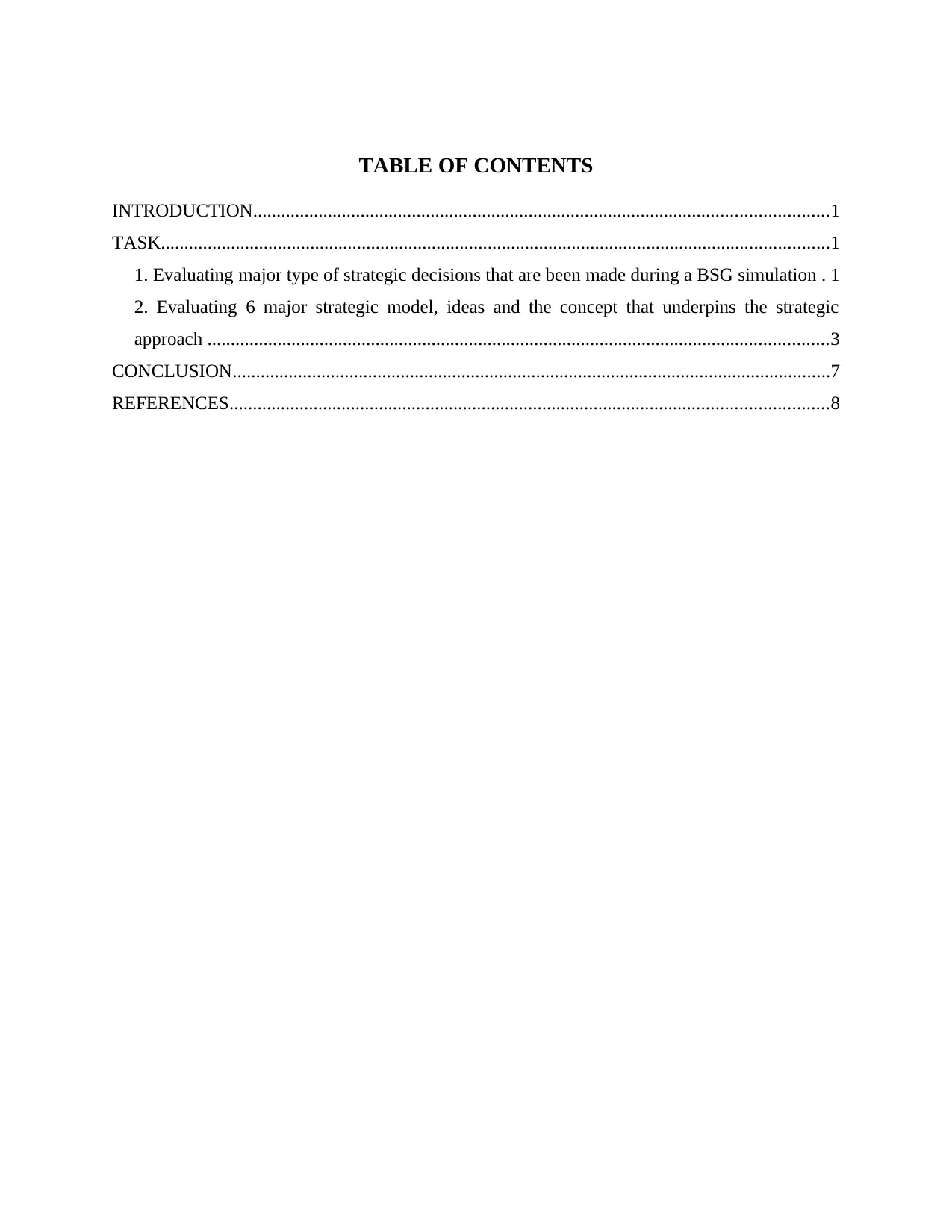
TABLE OF CONTENTS
INTRODUCTION...........................................................................................................................1
TASK...............................................................................................................................................1
1. Evaluating major type of strategic decisions that are been made during a BSG simulation . 1
2. Evaluating 6 major strategic model, ideas and the concept that underpins the strategic
approach .....................................................................................................................................3
CONCLUSION................................................................................................................................7
REFERENCES................................................................................................................................8
INTRODUCTION...........................................................................................................................1
TASK...............................................................................................................................................1
1. Evaluating major type of strategic decisions that are been made during a BSG simulation . 1
2. Evaluating 6 major strategic model, ideas and the concept that underpins the strategic
approach .....................................................................................................................................3
CONCLUSION................................................................................................................................7
REFERENCES................................................................................................................................8
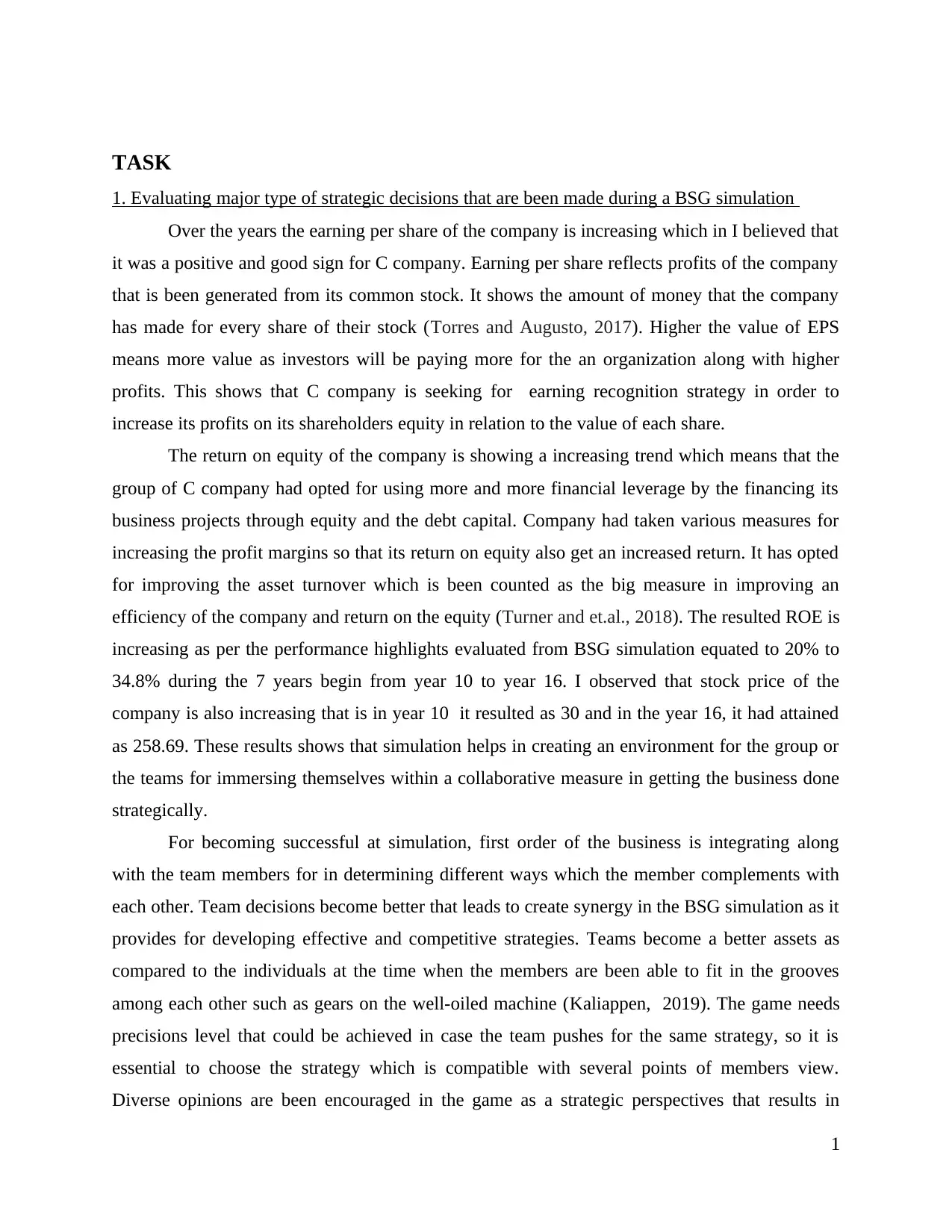
TASK
1. Evaluating major type of strategic decisions that are been made during a BSG simulation
Over the years the earning per share of the company is increasing which in I believed that
it was a positive and good sign for C company. Earning per share reflects profits of the company
that is been generated from its common stock. It shows the amount of money that the company
has made for every share of their stock (Torres and Augusto, 2017). Higher the value of EPS
means more value as investors will be paying more for the an organization along with higher
profits. This shows that C company is seeking for earning recognition strategy in order to
increase its profits on its shareholders equity in relation to the value of each share.
The return on equity of the company is showing a increasing trend which means that the
group of C company had opted for using more and more financial leverage by the financing its
business projects through equity and the debt capital. Company had taken various measures for
increasing the profit margins so that its return on equity also get an increased return. It has opted
for improving the asset turnover which is been counted as the big measure in improving an
efficiency of the company and return on the equity (Turner and et.al., 2018). The resulted ROE is
increasing as per the performance highlights evaluated from BSG simulation equated to 20% to
34.8% during the 7 years begin from year 10 to year 16. I observed that stock price of the
company is also increasing that is in year 10 it resulted as 30 and in the year 16, it had attained
as 258.69. These results shows that simulation helps in creating an environment for the group or
the teams for immersing themselves within a collaborative measure in getting the business done
strategically.
For becoming successful at simulation, first order of the business is integrating along
with the team members for in determining different ways which the member complements with
each other. Team decisions become better that leads to create synergy in the BSG simulation as it
provides for developing effective and competitive strategies. Teams become a better assets as
compared to the individuals at the time when the members are been able to fit in the grooves
among each other such as gears on the well-oiled machine (Kaliappen, 2019). The game needs
precisions level that could be achieved in case the team pushes for the same strategy, so it is
essential to choose the strategy which is compatible with several points of members view.
Diverse opinions are been encouraged in the game as a strategic perspectives that results in
1
1. Evaluating major type of strategic decisions that are been made during a BSG simulation
Over the years the earning per share of the company is increasing which in I believed that
it was a positive and good sign for C company. Earning per share reflects profits of the company
that is been generated from its common stock. It shows the amount of money that the company
has made for every share of their stock (Torres and Augusto, 2017). Higher the value of EPS
means more value as investors will be paying more for the an organization along with higher
profits. This shows that C company is seeking for earning recognition strategy in order to
increase its profits on its shareholders equity in relation to the value of each share.
The return on equity of the company is showing a increasing trend which means that the
group of C company had opted for using more and more financial leverage by the financing its
business projects through equity and the debt capital. Company had taken various measures for
increasing the profit margins so that its return on equity also get an increased return. It has opted
for improving the asset turnover which is been counted as the big measure in improving an
efficiency of the company and return on the equity (Turner and et.al., 2018). The resulted ROE is
increasing as per the performance highlights evaluated from BSG simulation equated to 20% to
34.8% during the 7 years begin from year 10 to year 16. I observed that stock price of the
company is also increasing that is in year 10 it resulted as 30 and in the year 16, it had attained
as 258.69. These results shows that simulation helps in creating an environment for the group or
the teams for immersing themselves within a collaborative measure in getting the business done
strategically.
For becoming successful at simulation, first order of the business is integrating along
with the team members for in determining different ways which the member complements with
each other. Team decisions become better that leads to create synergy in the BSG simulation as it
provides for developing effective and competitive strategies. Teams become a better assets as
compared to the individuals at the time when the members are been able to fit in the grooves
among each other such as gears on the well-oiled machine (Kaliappen, 2019). The game needs
precisions level that could be achieved in case the team pushes for the same strategy, so it is
essential to choose the strategy which is compatible with several points of members view.
Diverse opinions are been encouraged in the game as a strategic perspectives that results in
1
⊘ This is a preview!⊘
Do you want full access?
Subscribe today to unlock all pages.

Trusted by 1+ million students worldwide
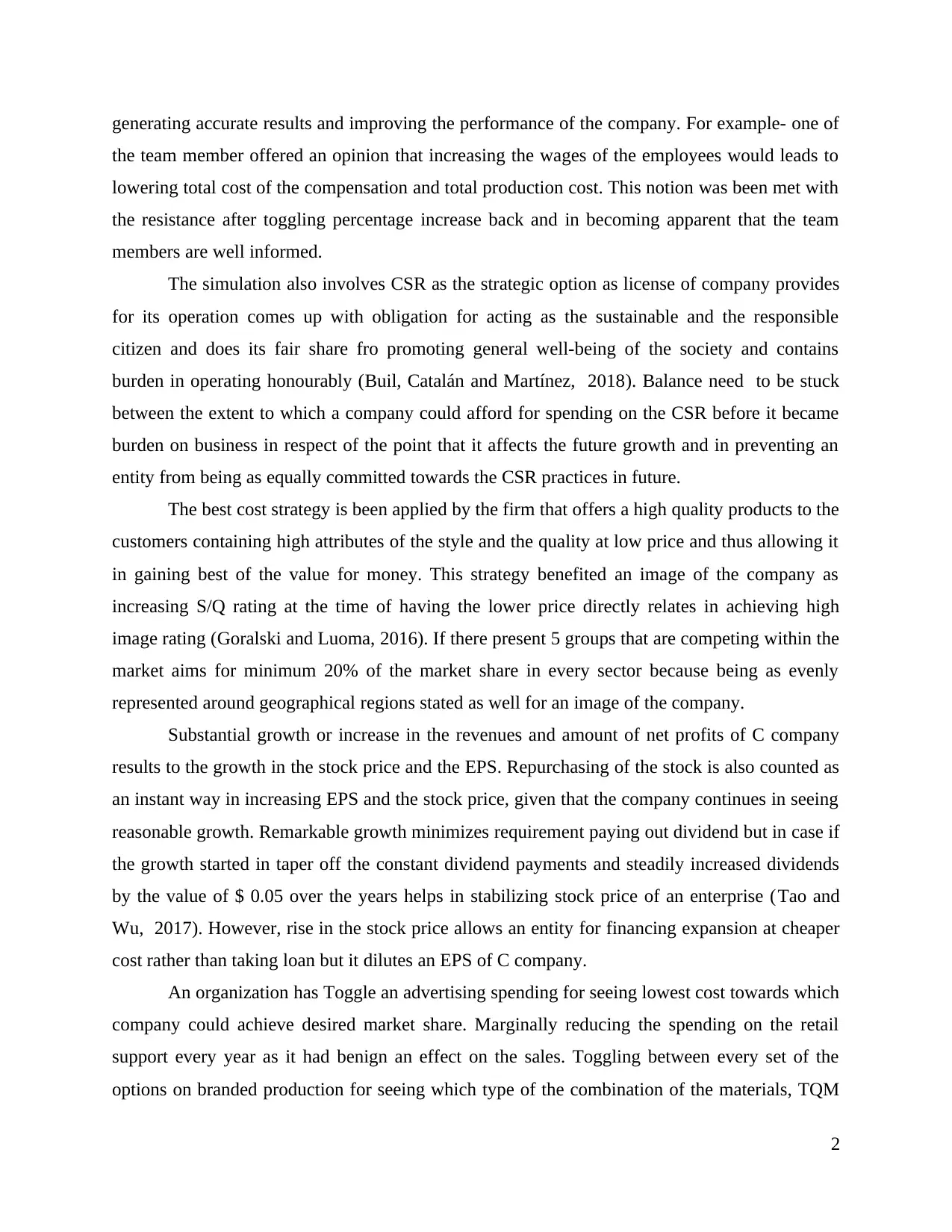
generating accurate results and improving the performance of the company. For example- one of
the team member offered an opinion that increasing the wages of the employees would leads to
lowering total cost of the compensation and total production cost. This notion was been met with
the resistance after toggling percentage increase back and in becoming apparent that the team
members are well informed.
The simulation also involves CSR as the strategic option as license of company provides
for its operation comes up with obligation for acting as the sustainable and the responsible
citizen and does its fair share fro promoting general well-being of the society and contains
burden in operating honourably (Buil, Catalán and Martínez, 2018). Balance need to be stuck
between the extent to which a company could afford for spending on the CSR before it became
burden on business in respect of the point that it affects the future growth and in preventing an
entity from being as equally committed towards the CSR practices in future.
The best cost strategy is been applied by the firm that offers a high quality products to the
customers containing high attributes of the style and the quality at low price and thus allowing it
in gaining best of the value for money. This strategy benefited an image of the company as
increasing S/Q rating at the time of having the lower price directly relates in achieving high
image rating (Goralski and Luoma, 2016). If there present 5 groups that are competing within the
market aims for minimum 20% of the market share in every sector because being as evenly
represented around geographical regions stated as well for an image of the company.
Substantial growth or increase in the revenues and amount of net profits of C company
results to the growth in the stock price and the EPS. Repurchasing of the stock is also counted as
an instant way in increasing EPS and the stock price, given that the company continues in seeing
reasonable growth. Remarkable growth minimizes requirement paying out dividend but in case if
the growth started in taper off the constant dividend payments and steadily increased dividends
by the value of $ 0.05 over the years helps in stabilizing stock price of an enterprise (Tao and
Wu, 2017). However, rise in the stock price allows an entity for financing expansion at cheaper
cost rather than taking loan but it dilutes an EPS of C company.
An organization has Toggle an advertising spending for seeing lowest cost towards which
company could achieve desired market share. Marginally reducing the spending on the retail
support every year as it had benign an effect on the sales. Toggling between every set of the
options on branded production for seeing which type of the combination of the materials, TQM
2
the team member offered an opinion that increasing the wages of the employees would leads to
lowering total cost of the compensation and total production cost. This notion was been met with
the resistance after toggling percentage increase back and in becoming apparent that the team
members are well informed.
The simulation also involves CSR as the strategic option as license of company provides
for its operation comes up with obligation for acting as the sustainable and the responsible
citizen and does its fair share fro promoting general well-being of the society and contains
burden in operating honourably (Buil, Catalán and Martínez, 2018). Balance need to be stuck
between the extent to which a company could afford for spending on the CSR before it became
burden on business in respect of the point that it affects the future growth and in preventing an
entity from being as equally committed towards the CSR practices in future.
The best cost strategy is been applied by the firm that offers a high quality products to the
customers containing high attributes of the style and the quality at low price and thus allowing it
in gaining best of the value for money. This strategy benefited an image of the company as
increasing S/Q rating at the time of having the lower price directly relates in achieving high
image rating (Goralski and Luoma, 2016). If there present 5 groups that are competing within the
market aims for minimum 20% of the market share in every sector because being as evenly
represented around geographical regions stated as well for an image of the company.
Substantial growth or increase in the revenues and amount of net profits of C company
results to the growth in the stock price and the EPS. Repurchasing of the stock is also counted as
an instant way in increasing EPS and the stock price, given that the company continues in seeing
reasonable growth. Remarkable growth minimizes requirement paying out dividend but in case if
the growth started in taper off the constant dividend payments and steadily increased dividends
by the value of $ 0.05 over the years helps in stabilizing stock price of an enterprise (Tao and
Wu, 2017). However, rise in the stock price allows an entity for financing expansion at cheaper
cost rather than taking loan but it dilutes an EPS of C company.
An organization has Toggle an advertising spending for seeing lowest cost towards which
company could achieve desired market share. Marginally reducing the spending on the retail
support every year as it had benign an effect on the sales. Toggling between every set of the
options on branded production for seeing which type of the combination of the materials, TQM
2
Paraphrase This Document
Need a fresh take? Get an instant paraphrase of this document with our AI Paraphraser
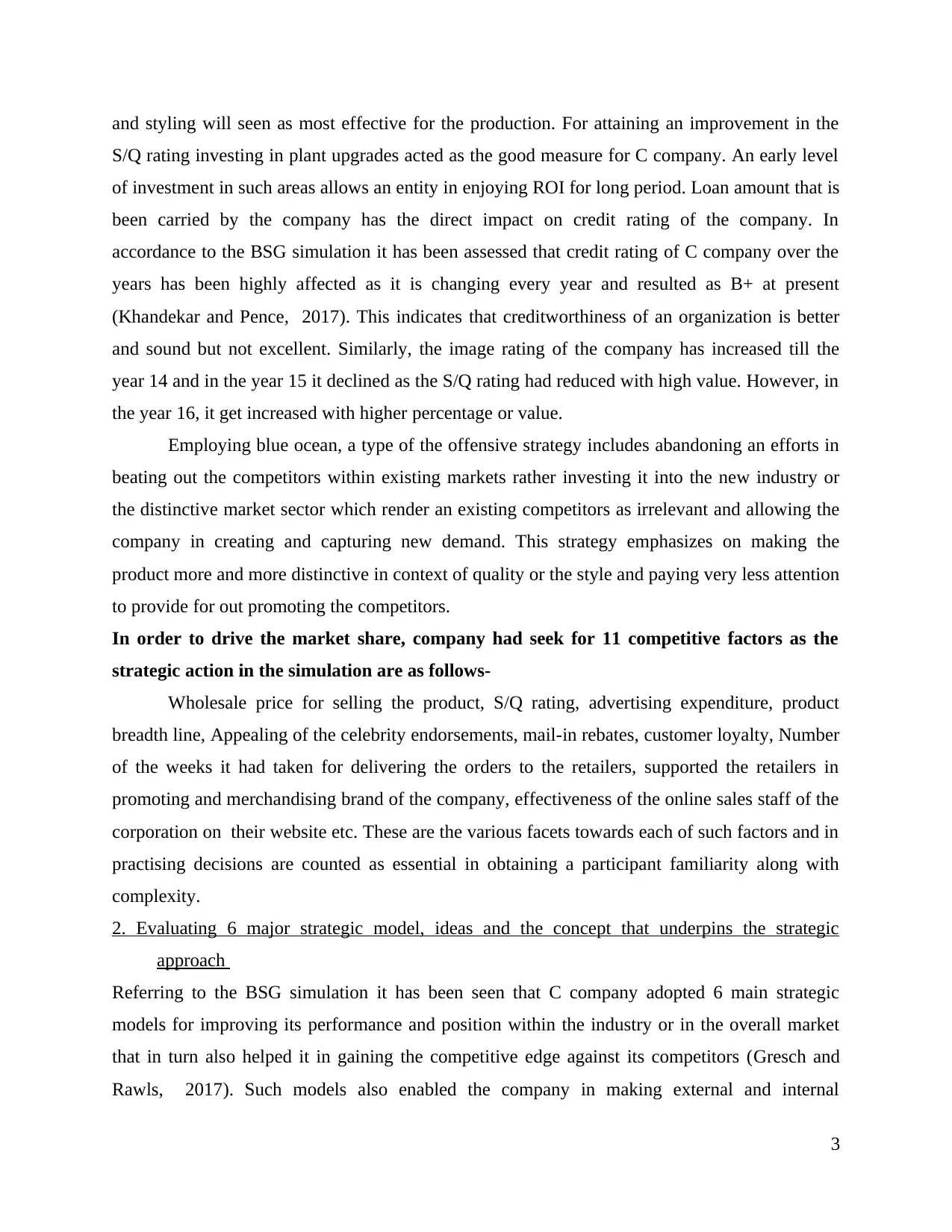
and styling will seen as most effective for the production. For attaining an improvement in the
S/Q rating investing in plant upgrades acted as the good measure for C company. An early level
of investment in such areas allows an entity in enjoying ROI for long period. Loan amount that is
been carried by the company has the direct impact on credit rating of the company. In
accordance to the BSG simulation it has been assessed that credit rating of C company over the
years has been highly affected as it is changing every year and resulted as B+ at present
(Khandekar and Pence, 2017). This indicates that creditworthiness of an organization is better
and sound but not excellent. Similarly, the image rating of the company has increased till the
year 14 and in the year 15 it declined as the S/Q rating had reduced with high value. However, in
the year 16, it get increased with higher percentage or value.
Employing blue ocean, a type of the offensive strategy includes abandoning an efforts in
beating out the competitors within existing markets rather investing it into the new industry or
the distinctive market sector which render an existing competitors as irrelevant and allowing the
company in creating and capturing new demand. This strategy emphasizes on making the
product more and more distinctive in context of quality or the style and paying very less attention
to provide for out promoting the competitors.
In order to drive the market share, company had seek for 11 competitive factors as the
strategic action in the simulation are as follows-
Wholesale price for selling the product, S/Q rating, advertising expenditure, product
breadth line, Appealing of the celebrity endorsements, mail-in rebates, customer loyalty, Number
of the weeks it had taken for delivering the orders to the retailers, supported the retailers in
promoting and merchandising brand of the company, effectiveness of the online sales staff of the
corporation on their website etc. These are the various facets towards each of such factors and in
practising decisions are counted as essential in obtaining a participant familiarity along with
complexity.
2. Evaluating 6 major strategic model, ideas and the concept that underpins the strategic
approach
Referring to the BSG simulation it has been seen that C company adopted 6 main strategic
models for improving its performance and position within the industry or in the overall market
that in turn also helped it in gaining the competitive edge against its competitors (Gresch and
Rawls, 2017). Such models also enabled the company in making external and internal
3
S/Q rating investing in plant upgrades acted as the good measure for C company. An early level
of investment in such areas allows an entity in enjoying ROI for long period. Loan amount that is
been carried by the company has the direct impact on credit rating of the company. In
accordance to the BSG simulation it has been assessed that credit rating of C company over the
years has been highly affected as it is changing every year and resulted as B+ at present
(Khandekar and Pence, 2017). This indicates that creditworthiness of an organization is better
and sound but not excellent. Similarly, the image rating of the company has increased till the
year 14 and in the year 15 it declined as the S/Q rating had reduced with high value. However, in
the year 16, it get increased with higher percentage or value.
Employing blue ocean, a type of the offensive strategy includes abandoning an efforts in
beating out the competitors within existing markets rather investing it into the new industry or
the distinctive market sector which render an existing competitors as irrelevant and allowing the
company in creating and capturing new demand. This strategy emphasizes on making the
product more and more distinctive in context of quality or the style and paying very less attention
to provide for out promoting the competitors.
In order to drive the market share, company had seek for 11 competitive factors as the
strategic action in the simulation are as follows-
Wholesale price for selling the product, S/Q rating, advertising expenditure, product
breadth line, Appealing of the celebrity endorsements, mail-in rebates, customer loyalty, Number
of the weeks it had taken for delivering the orders to the retailers, supported the retailers in
promoting and merchandising brand of the company, effectiveness of the online sales staff of the
corporation on their website etc. These are the various facets towards each of such factors and in
practising decisions are counted as essential in obtaining a participant familiarity along with
complexity.
2. Evaluating 6 major strategic model, ideas and the concept that underpins the strategic
approach
Referring to the BSG simulation it has been seen that C company adopted 6 main strategic
models for improving its performance and position within the industry or in the overall market
that in turn also helped it in gaining the competitive edge against its competitors (Gresch and
Rawls, 2017). Such models also enabled the company in making external and internal
3
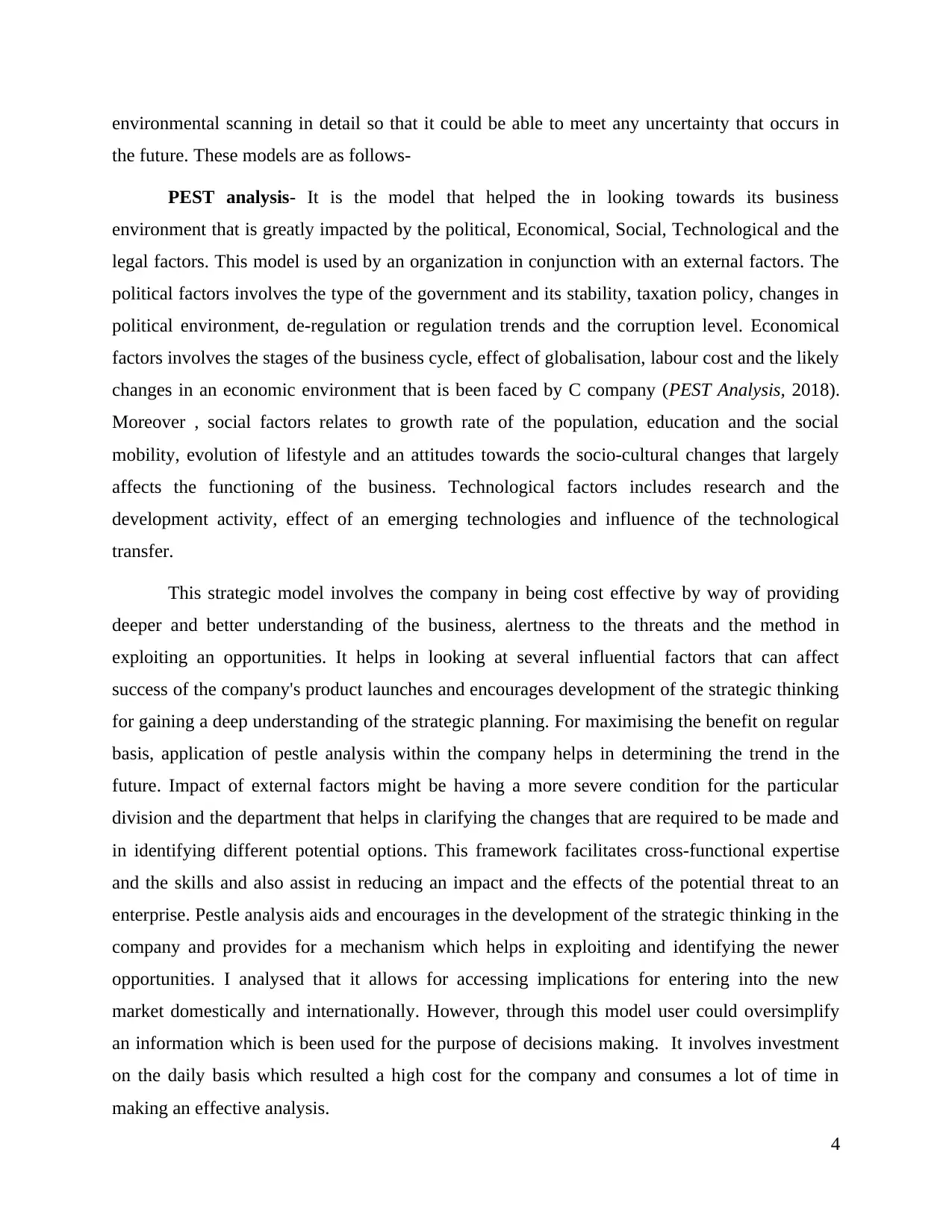
environmental scanning in detail so that it could be able to meet any uncertainty that occurs in
the future. These models are as follows-
PEST analysis- It is the model that helped the in looking towards its business
environment that is greatly impacted by the political, Economical, Social, Technological and the
legal factors. This model is used by an organization in conjunction with an external factors. The
political factors involves the type of the government and its stability, taxation policy, changes in
political environment, de-regulation or regulation trends and the corruption level. Economical
factors involves the stages of the business cycle, effect of globalisation, labour cost and the likely
changes in an economic environment that is been faced by C company (PEST Analysis, 2018).
Moreover , social factors relates to growth rate of the population, education and the social
mobility, evolution of lifestyle and an attitudes towards the socio-cultural changes that largely
affects the functioning of the business. Technological factors includes research and the
development activity, effect of an emerging technologies and influence of the technological
transfer.
This strategic model involves the company in being cost effective by way of providing
deeper and better understanding of the business, alertness to the threats and the method in
exploiting an opportunities. It helps in looking at several influential factors that can affect
success of the company's product launches and encourages development of the strategic thinking
for gaining a deep understanding of the strategic planning. For maximising the benefit on regular
basis, application of pestle analysis within the company helps in determining the trend in the
future. Impact of external factors might be having a more severe condition for the particular
division and the department that helps in clarifying the changes that are required to be made and
in identifying different potential options. This framework facilitates cross-functional expertise
and the skills and also assist in reducing an impact and the effects of the potential threat to an
enterprise. Pestle analysis aids and encourages in the development of the strategic thinking in the
company and provides for a mechanism which helps in exploiting and identifying the newer
opportunities. I analysed that it allows for accessing implications for entering into the new
market domestically and internationally. However, through this model user could oversimplify
an information which is been used for the purpose of decisions making. It involves investment
on the daily basis which resulted a high cost for the company and consumes a lot of time in
making an effective analysis.
4
the future. These models are as follows-
PEST analysis- It is the model that helped the in looking towards its business
environment that is greatly impacted by the political, Economical, Social, Technological and the
legal factors. This model is used by an organization in conjunction with an external factors. The
political factors involves the type of the government and its stability, taxation policy, changes in
political environment, de-regulation or regulation trends and the corruption level. Economical
factors involves the stages of the business cycle, effect of globalisation, labour cost and the likely
changes in an economic environment that is been faced by C company (PEST Analysis, 2018).
Moreover , social factors relates to growth rate of the population, education and the social
mobility, evolution of lifestyle and an attitudes towards the socio-cultural changes that largely
affects the functioning of the business. Technological factors includes research and the
development activity, effect of an emerging technologies and influence of the technological
transfer.
This strategic model involves the company in being cost effective by way of providing
deeper and better understanding of the business, alertness to the threats and the method in
exploiting an opportunities. It helps in looking at several influential factors that can affect
success of the company's product launches and encourages development of the strategic thinking
for gaining a deep understanding of the strategic planning. For maximising the benefit on regular
basis, application of pestle analysis within the company helps in determining the trend in the
future. Impact of external factors might be having a more severe condition for the particular
division and the department that helps in clarifying the changes that are required to be made and
in identifying different potential options. This framework facilitates cross-functional expertise
and the skills and also assist in reducing an impact and the effects of the potential threat to an
enterprise. Pestle analysis aids and encourages in the development of the strategic thinking in the
company and provides for a mechanism which helps in exploiting and identifying the newer
opportunities. I analysed that it allows for accessing implications for entering into the new
market domestically and internationally. However, through this model user could oversimplify
an information which is been used for the purpose of decisions making. It involves investment
on the daily basis which resulted a high cost for the company and consumes a lot of time in
making an effective analysis.
4
⊘ This is a preview!⊘
Do you want full access?
Subscribe today to unlock all pages.

Trusted by 1+ million students worldwide
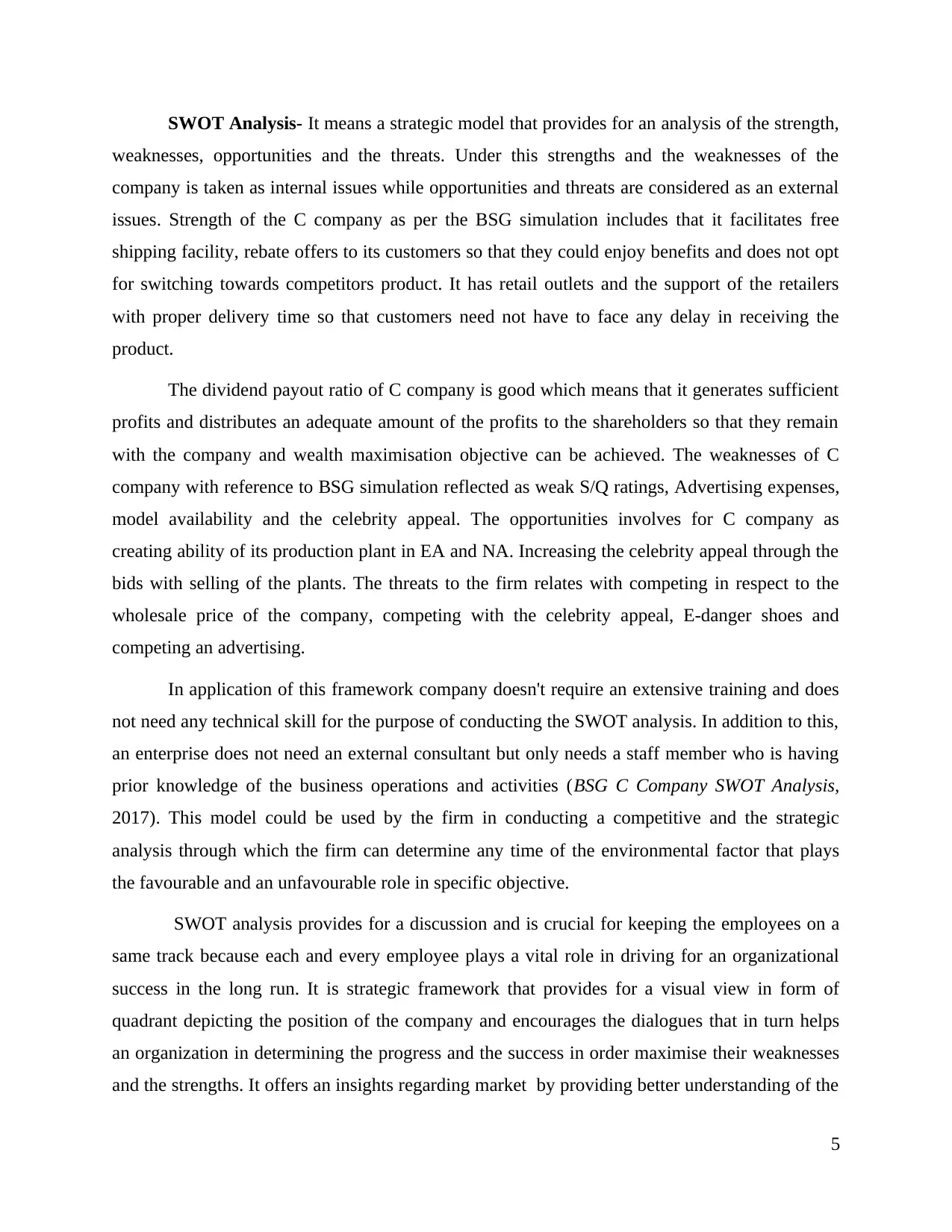
SWOT Analysis- It means a strategic model that provides for an analysis of the strength,
weaknesses, opportunities and the threats. Under this strengths and the weaknesses of the
company is taken as internal issues while opportunities and threats are considered as an external
issues. Strength of the C company as per the BSG simulation includes that it facilitates free
shipping facility, rebate offers to its customers so that they could enjoy benefits and does not opt
for switching towards competitors product. It has retail outlets and the support of the retailers
with proper delivery time so that customers need not have to face any delay in receiving the
product.
The dividend payout ratio of C company is good which means that it generates sufficient
profits and distributes an adequate amount of the profits to the shareholders so that they remain
with the company and wealth maximisation objective can be achieved. The weaknesses of C
company with reference to BSG simulation reflected as weak S/Q ratings, Advertising expenses,
model availability and the celebrity appeal. The opportunities involves for C company as
creating ability of its production plant in EA and NA. Increasing the celebrity appeal through the
bids with selling of the plants. The threats to the firm relates with competing in respect to the
wholesale price of the company, competing with the celebrity appeal, E-danger shoes and
competing an advertising.
In application of this framework company doesn't require an extensive training and does
not need any technical skill for the purpose of conducting the SWOT analysis. In addition to this,
an enterprise does not need an external consultant but only needs a staff member who is having
prior knowledge of the business operations and activities (BSG C Company SWOT Analysis,
2017). This model could be used by the firm in conducting a competitive and the strategic
analysis through which the firm can determine any time of the environmental factor that plays
the favourable and an unfavourable role in specific objective.
SWOT analysis provides for a discussion and is crucial for keeping the employees on a
same track because each and every employee plays a vital role in driving for an organizational
success in the long run. It is strategic framework that provides for a visual view in form of
quadrant depicting the position of the company and encourages the dialogues that in turn helps
an organization in determining the progress and the success in order maximise their weaknesses
and the strengths. It offers an insights regarding market by providing better understanding of the
5
weaknesses, opportunities and the threats. Under this strengths and the weaknesses of the
company is taken as internal issues while opportunities and threats are considered as an external
issues. Strength of the C company as per the BSG simulation includes that it facilitates free
shipping facility, rebate offers to its customers so that they could enjoy benefits and does not opt
for switching towards competitors product. It has retail outlets and the support of the retailers
with proper delivery time so that customers need not have to face any delay in receiving the
product.
The dividend payout ratio of C company is good which means that it generates sufficient
profits and distributes an adequate amount of the profits to the shareholders so that they remain
with the company and wealth maximisation objective can be achieved. The weaknesses of C
company with reference to BSG simulation reflected as weak S/Q ratings, Advertising expenses,
model availability and the celebrity appeal. The opportunities involves for C company as
creating ability of its production plant in EA and NA. Increasing the celebrity appeal through the
bids with selling of the plants. The threats to the firm relates with competing in respect to the
wholesale price of the company, competing with the celebrity appeal, E-danger shoes and
competing an advertising.
In application of this framework company doesn't require an extensive training and does
not need any technical skill for the purpose of conducting the SWOT analysis. In addition to this,
an enterprise does not need an external consultant but only needs a staff member who is having
prior knowledge of the business operations and activities (BSG C Company SWOT Analysis,
2017). This model could be used by the firm in conducting a competitive and the strategic
analysis through which the firm can determine any time of the environmental factor that plays
the favourable and an unfavourable role in specific objective.
SWOT analysis provides for a discussion and is crucial for keeping the employees on a
same track because each and every employee plays a vital role in driving for an organizational
success in the long run. It is strategic framework that provides for a visual view in form of
quadrant depicting the position of the company and encourages the dialogues that in turn helps
an organization in determining the progress and the success in order maximise their weaknesses
and the strengths. It offers an insights regarding market by providing better understanding of the
5
Paraphrase This Document
Need a fresh take? Get an instant paraphrase of this document with our AI Paraphraser
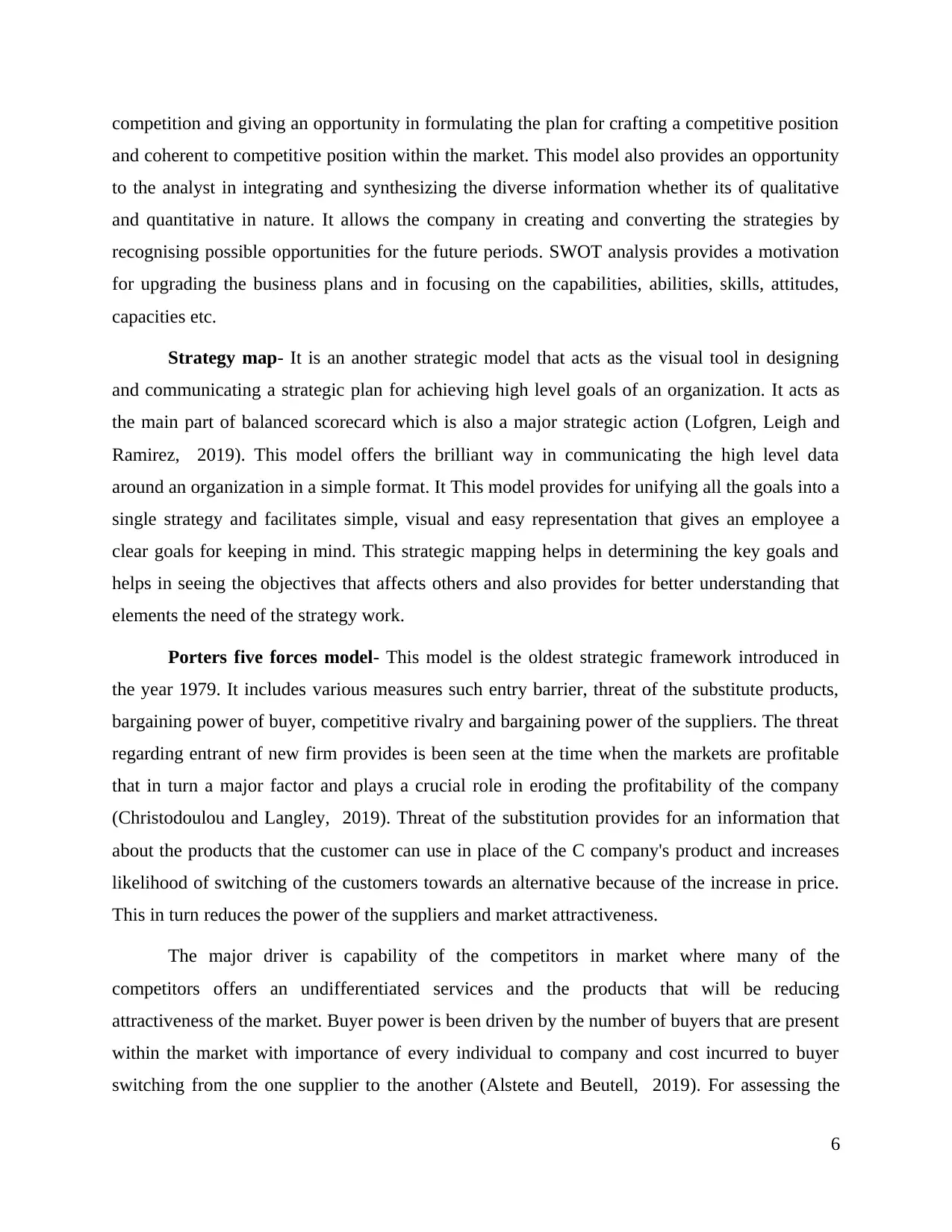
competition and giving an opportunity in formulating the plan for crafting a competitive position
and coherent to competitive position within the market. This model also provides an opportunity
to the analyst in integrating and synthesizing the diverse information whether its of qualitative
and quantitative in nature. It allows the company in creating and converting the strategies by
recognising possible opportunities for the future periods. SWOT analysis provides a motivation
for upgrading the business plans and in focusing on the capabilities, abilities, skills, attitudes,
capacities etc.
Strategy map- It is an another strategic model that acts as the visual tool in designing
and communicating a strategic plan for achieving high level goals of an organization. It acts as
the main part of balanced scorecard which is also a major strategic action (Lofgren, Leigh and
Ramirez, 2019). This model offers the brilliant way in communicating the high level data
around an organization in a simple format. It This model provides for unifying all the goals into a
single strategy and facilitates simple, visual and easy representation that gives an employee a
clear goals for keeping in mind. This strategic mapping helps in determining the key goals and
helps in seeing the objectives that affects others and also provides for better understanding that
elements the need of the strategy work.
Porters five forces model- This model is the oldest strategic framework introduced in
the year 1979. It includes various measures such entry barrier, threat of the substitute products,
bargaining power of buyer, competitive rivalry and bargaining power of the suppliers. The threat
regarding entrant of new firm provides is been seen at the time when the markets are profitable
that in turn a major factor and plays a crucial role in eroding the profitability of the company
(Christodoulou and Langley, 2019). Threat of the substitution provides for an information that
about the products that the customer can use in place of the C company's product and increases
likelihood of switching of the customers towards an alternative because of the increase in price.
This in turn reduces the power of the suppliers and market attractiveness.
The major driver is capability of the competitors in market where many of the
competitors offers an undifferentiated services and the products that will be reducing
attractiveness of the market. Buyer power is been driven by the number of buyers that are present
within the market with importance of every individual to company and cost incurred to buyer
switching from the one supplier to the another (Alstete and Beutell, 2019). For assessing the
6
and coherent to competitive position within the market. This model also provides an opportunity
to the analyst in integrating and synthesizing the diverse information whether its of qualitative
and quantitative in nature. It allows the company in creating and converting the strategies by
recognising possible opportunities for the future periods. SWOT analysis provides a motivation
for upgrading the business plans and in focusing on the capabilities, abilities, skills, attitudes,
capacities etc.
Strategy map- It is an another strategic model that acts as the visual tool in designing
and communicating a strategic plan for achieving high level goals of an organization. It acts as
the main part of balanced scorecard which is also a major strategic action (Lofgren, Leigh and
Ramirez, 2019). This model offers the brilliant way in communicating the high level data
around an organization in a simple format. It This model provides for unifying all the goals into a
single strategy and facilitates simple, visual and easy representation that gives an employee a
clear goals for keeping in mind. This strategic mapping helps in determining the key goals and
helps in seeing the objectives that affects others and also provides for better understanding that
elements the need of the strategy work.
Porters five forces model- This model is the oldest strategic framework introduced in
the year 1979. It includes various measures such entry barrier, threat of the substitute products,
bargaining power of buyer, competitive rivalry and bargaining power of the suppliers. The threat
regarding entrant of new firm provides is been seen at the time when the markets are profitable
that in turn a major factor and plays a crucial role in eroding the profitability of the company
(Christodoulou and Langley, 2019). Threat of the substitution provides for an information that
about the products that the customer can use in place of the C company's product and increases
likelihood of switching of the customers towards an alternative because of the increase in price.
This in turn reduces the power of the suppliers and market attractiveness.
The major driver is capability of the competitors in market where many of the
competitors offers an undifferentiated services and the products that will be reducing
attractiveness of the market. Buyer power is been driven by the number of buyers that are present
within the market with importance of every individual to company and cost incurred to buyer
switching from the one supplier to the another (Alstete and Beutell, 2019). For assessing the
6
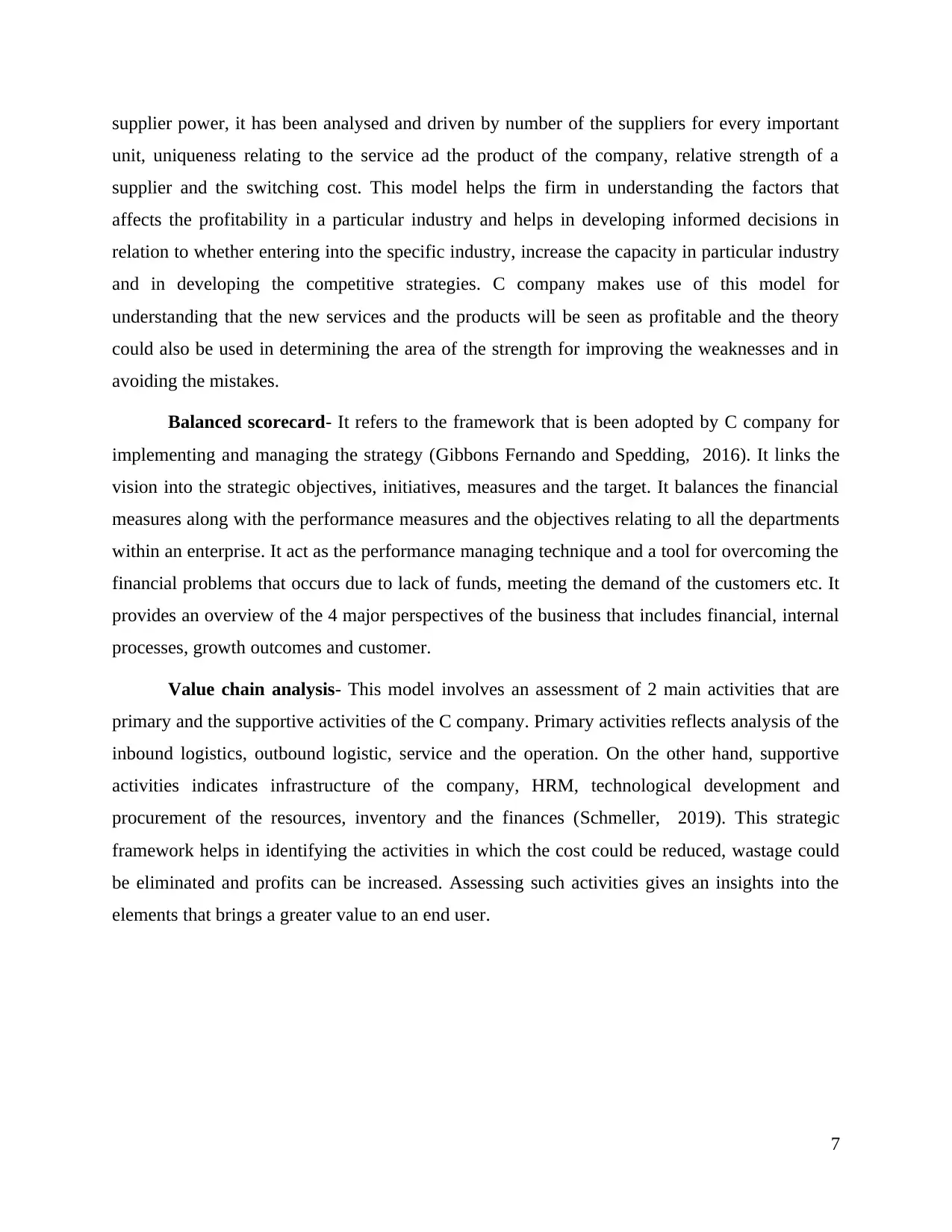
supplier power, it has been analysed and driven by number of the suppliers for every important
unit, uniqueness relating to the service ad the product of the company, relative strength of a
supplier and the switching cost. This model helps the firm in understanding the factors that
affects the profitability in a particular industry and helps in developing informed decisions in
relation to whether entering into the specific industry, increase the capacity in particular industry
and in developing the competitive strategies. C company makes use of this model for
understanding that the new services and the products will be seen as profitable and the theory
could also be used in determining the area of the strength for improving the weaknesses and in
avoiding the mistakes.
Balanced scorecard- It refers to the framework that is been adopted by C company for
implementing and managing the strategy (Gibbons Fernando and Spedding, 2016). It links the
vision into the strategic objectives, initiatives, measures and the target. It balances the financial
measures along with the performance measures and the objectives relating to all the departments
within an enterprise. It act as the performance managing technique and a tool for overcoming the
financial problems that occurs due to lack of funds, meeting the demand of the customers etc. It
provides an overview of the 4 major perspectives of the business that includes financial, internal
processes, growth outcomes and customer.
Value chain analysis- This model involves an assessment of 2 main activities that are
primary and the supportive activities of the C company. Primary activities reflects analysis of the
inbound logistics, outbound logistic, service and the operation. On the other hand, supportive
activities indicates infrastructure of the company, HRM, technological development and
procurement of the resources, inventory and the finances (Schmeller, 2019). This strategic
framework helps in identifying the activities in which the cost could be reduced, wastage could
be eliminated and profits can be increased. Assessing such activities gives an insights into the
elements that brings a greater value to an end user.
7
unit, uniqueness relating to the service ad the product of the company, relative strength of a
supplier and the switching cost. This model helps the firm in understanding the factors that
affects the profitability in a particular industry and helps in developing informed decisions in
relation to whether entering into the specific industry, increase the capacity in particular industry
and in developing the competitive strategies. C company makes use of this model for
understanding that the new services and the products will be seen as profitable and the theory
could also be used in determining the area of the strength for improving the weaknesses and in
avoiding the mistakes.
Balanced scorecard- It refers to the framework that is been adopted by C company for
implementing and managing the strategy (Gibbons Fernando and Spedding, 2016). It links the
vision into the strategic objectives, initiatives, measures and the target. It balances the financial
measures along with the performance measures and the objectives relating to all the departments
within an enterprise. It act as the performance managing technique and a tool for overcoming the
financial problems that occurs due to lack of funds, meeting the demand of the customers etc. It
provides an overview of the 4 major perspectives of the business that includes financial, internal
processes, growth outcomes and customer.
Value chain analysis- This model involves an assessment of 2 main activities that are
primary and the supportive activities of the C company. Primary activities reflects analysis of the
inbound logistics, outbound logistic, service and the operation. On the other hand, supportive
activities indicates infrastructure of the company, HRM, technological development and
procurement of the resources, inventory and the finances (Schmeller, 2019). This strategic
framework helps in identifying the activities in which the cost could be reduced, wastage could
be eliminated and profits can be increased. Assessing such activities gives an insights into the
elements that brings a greater value to an end user.
7
⊘ This is a preview!⊘
Do you want full access?
Subscribe today to unlock all pages.

Trusted by 1+ million students worldwide
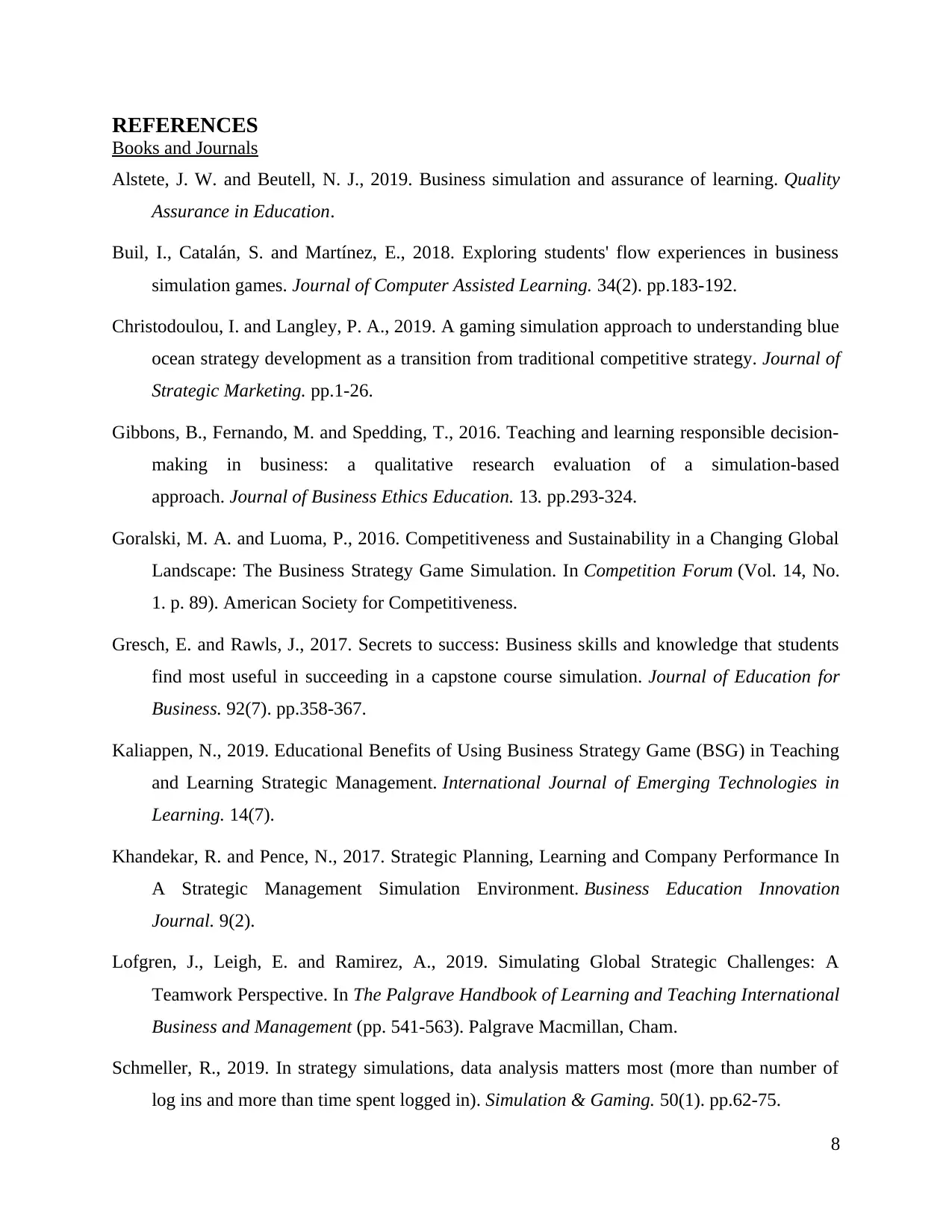
REFERENCES
Books and Journals
Alstete, J. W. and Beutell, N. J., 2019. Business simulation and assurance of learning. Quality
Assurance in Education.
Buil, I., Catalán, S. and Martínez, E., 2018. Exploring students' flow experiences in business
simulation games. Journal of Computer Assisted Learning. 34(2). pp.183-192.
Christodoulou, I. and Langley, P. A., 2019. A gaming simulation approach to understanding blue
ocean strategy development as a transition from traditional competitive strategy. Journal of
Strategic Marketing. pp.1-26.
Gibbons, B., Fernando, M. and Spedding, T., 2016. Teaching and learning responsible decision-
making in business: a qualitative research evaluation of a simulation-based
approach. Journal of Business Ethics Education. 13. pp.293-324.
Goralski, M. A. and Luoma, P., 2016. Competitiveness and Sustainability in a Changing Global
Landscape: The Business Strategy Game Simulation. In Competition Forum (Vol. 14, No.
1. p. 89). American Society for Competitiveness.
Gresch, E. and Rawls, J., 2017. Secrets to success: Business skills and knowledge that students
find most useful in succeeding in a capstone course simulation. Journal of Education for
Business. 92(7). pp.358-367.
Kaliappen, N., 2019. Educational Benefits of Using Business Strategy Game (BSG) in Teaching
and Learning Strategic Management. International Journal of Emerging Technologies in
Learning. 14(7).
Khandekar, R. and Pence, N., 2017. Strategic Planning, Learning and Company Performance In
A Strategic Management Simulation Environment. Business Education Innovation
Journal. 9(2).
Lofgren, J., Leigh, E. and Ramirez, A., 2019. Simulating Global Strategic Challenges: A
Teamwork Perspective. In The Palgrave Handbook of Learning and Teaching International
Business and Management (pp. 541-563). Palgrave Macmillan, Cham.
Schmeller, R., 2019. In strategy simulations, data analysis matters most (more than number of
log ins and more than time spent logged in). Simulation & Gaming. 50(1). pp.62-75.
8
Books and Journals
Alstete, J. W. and Beutell, N. J., 2019. Business simulation and assurance of learning. Quality
Assurance in Education.
Buil, I., Catalán, S. and Martínez, E., 2018. Exploring students' flow experiences in business
simulation games. Journal of Computer Assisted Learning. 34(2). pp.183-192.
Christodoulou, I. and Langley, P. A., 2019. A gaming simulation approach to understanding blue
ocean strategy development as a transition from traditional competitive strategy. Journal of
Strategic Marketing. pp.1-26.
Gibbons, B., Fernando, M. and Spedding, T., 2016. Teaching and learning responsible decision-
making in business: a qualitative research evaluation of a simulation-based
approach. Journal of Business Ethics Education. 13. pp.293-324.
Goralski, M. A. and Luoma, P., 2016. Competitiveness and Sustainability in a Changing Global
Landscape: The Business Strategy Game Simulation. In Competition Forum (Vol. 14, No.
1. p. 89). American Society for Competitiveness.
Gresch, E. and Rawls, J., 2017. Secrets to success: Business skills and knowledge that students
find most useful in succeeding in a capstone course simulation. Journal of Education for
Business. 92(7). pp.358-367.
Kaliappen, N., 2019. Educational Benefits of Using Business Strategy Game (BSG) in Teaching
and Learning Strategic Management. International Journal of Emerging Technologies in
Learning. 14(7).
Khandekar, R. and Pence, N., 2017. Strategic Planning, Learning and Company Performance In
A Strategic Management Simulation Environment. Business Education Innovation
Journal. 9(2).
Lofgren, J., Leigh, E. and Ramirez, A., 2019. Simulating Global Strategic Challenges: A
Teamwork Perspective. In The Palgrave Handbook of Learning and Teaching International
Business and Management (pp. 541-563). Palgrave Macmillan, Cham.
Schmeller, R., 2019. In strategy simulations, data analysis matters most (more than number of
log ins and more than time spent logged in). Simulation & Gaming. 50(1). pp.62-75.
8
Paraphrase This Document
Need a fresh take? Get an instant paraphrase of this document with our AI Paraphraser
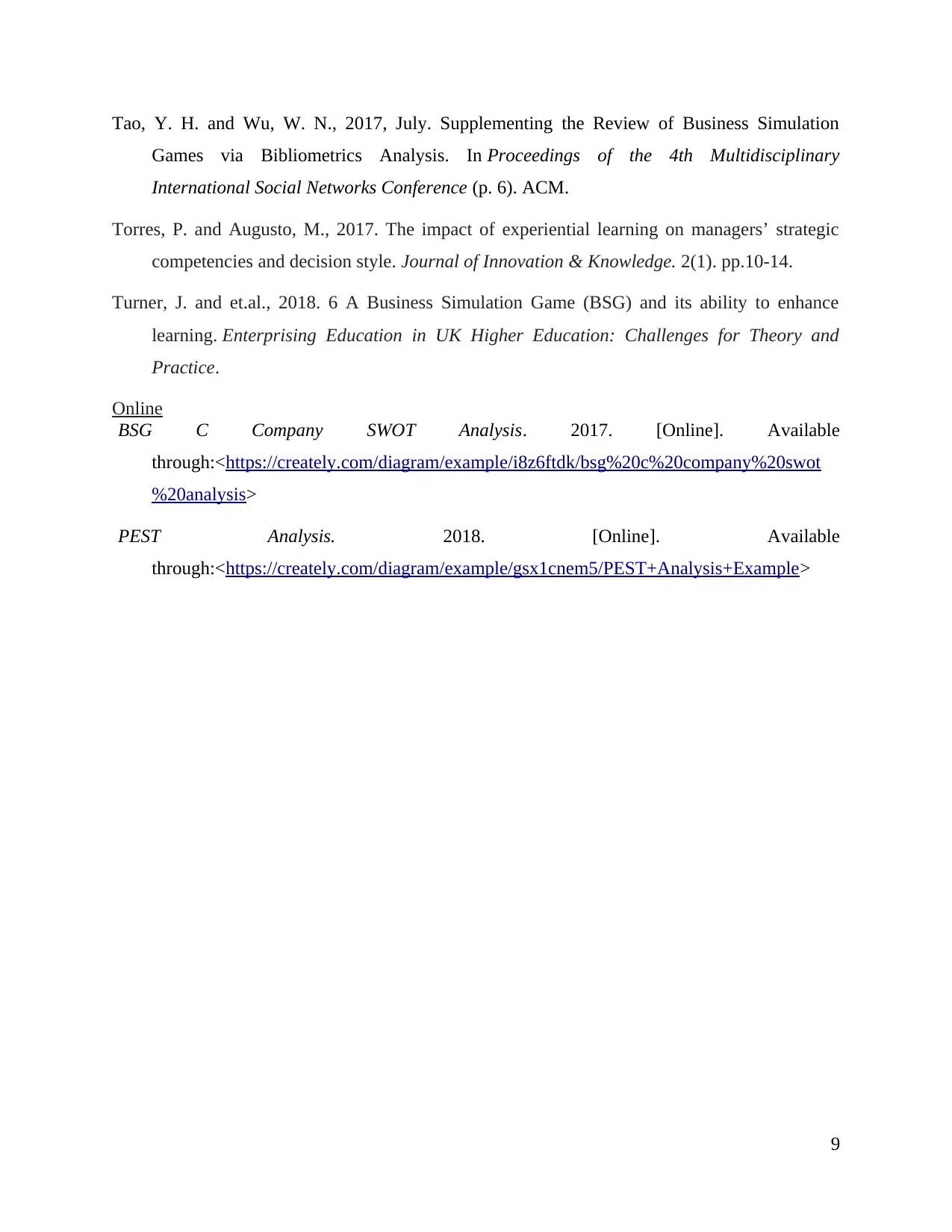
Tao, Y. H. and Wu, W. N., 2017, July. Supplementing the Review of Business Simulation
Games via Bibliometrics Analysis. In Proceedings of the 4th Multidisciplinary
International Social Networks Conference (p. 6). ACM.
Torres, P. and Augusto, M., 2017. The impact of experiential learning on managers’ strategic
competencies and decision style. Journal of Innovation & Knowledge. 2(1). pp.10-14.
Turner, J. and et.al., 2018. 6 A Business Simulation Game (BSG) and its ability to enhance
learning. Enterprising Education in UK Higher Education: Challenges for Theory and
Practice.
Online
BSG C Company SWOT Analysis. 2017. [Online]. Available
through:<https://creately.com/diagram/example/i8z6ftdk/bsg%20c%20company%20swot
%20analysis>
PEST Analysis. 2018. [Online]. Available
through:<https://creately.com/diagram/example/gsx1cnem5/PEST+Analysis+Example>
9
Games via Bibliometrics Analysis. In Proceedings of the 4th Multidisciplinary
International Social Networks Conference (p. 6). ACM.
Torres, P. and Augusto, M., 2017. The impact of experiential learning on managers’ strategic
competencies and decision style. Journal of Innovation & Knowledge. 2(1). pp.10-14.
Turner, J. and et.al., 2018. 6 A Business Simulation Game (BSG) and its ability to enhance
learning. Enterprising Education in UK Higher Education: Challenges for Theory and
Practice.
Online
BSG C Company SWOT Analysis. 2017. [Online]. Available
through:<https://creately.com/diagram/example/i8z6ftdk/bsg%20c%20company%20swot
%20analysis>
PEST Analysis. 2018. [Online]. Available
through:<https://creately.com/diagram/example/gsx1cnem5/PEST+Analysis+Example>
9
1 out of 11
Related Documents
Your All-in-One AI-Powered Toolkit for Academic Success.
+13062052269
info@desklib.com
Available 24*7 on WhatsApp / Email
![[object Object]](/_next/static/media/star-bottom.7253800d.svg)
Unlock your academic potential
Copyright © 2020–2025 A2Z Services. All Rights Reserved. Developed and managed by ZUCOL.





